None lumpy cam
Discussion
GRIFFONMARK said:
I have a cam which is quite lumpy lying on my workbench. How do I tell what it is, what it does, etc.?
Regards
Mark
Mark,Regards
Mark
If you look at the back end of the cam there should be some sort of ID numbers. Then you can post the numbers on here where some one will, probably, be able to identify it.
Phil Mycock said:
...bonus points if you know what the two white wires with grey connectors, hanging out of the loom at rear centre of the bay are for... 
I have no idea but on the V8S (Hotwire EFi) there is a slightly different connector in the same location with a grey and white wire which I haven't identified and doesn't connect to anything. 
I wondered if it was something to do with the RR cruise control but it was only a wild guess.
I also have thought about a bit more cam lube too (I too have a worn cam but not as bad as that) - I don't think the idea is as stupid as it sounds.
The old Ford Pinto 2 litre engine had a pipe next to the cam squirting a fine jet of oil onto each lobe (well most of the time, remember those old Cortinas and Sierras going tap tap tap tap tap!)
I wondered if something like this could be make to work from the oil supply somewhere - I'm just not sure if I'm brave enough to start drilling holes in my block to hook it up to an oil gallery.
I thought the pipe could be made to run in the valley along the top of the cam with a small oil hole pointing downwards at each lobe, something like a bit of copper brake pipe would do it I thought.
Worst lobe on mine was 5th from the front which probably isn't significant.
Symptoms on mine were a slight misfire at high revs and it was a bit lethargic to pull away from a standstill.
Fuel economy had also taken a significant dive.
Worst 5th from front of cam
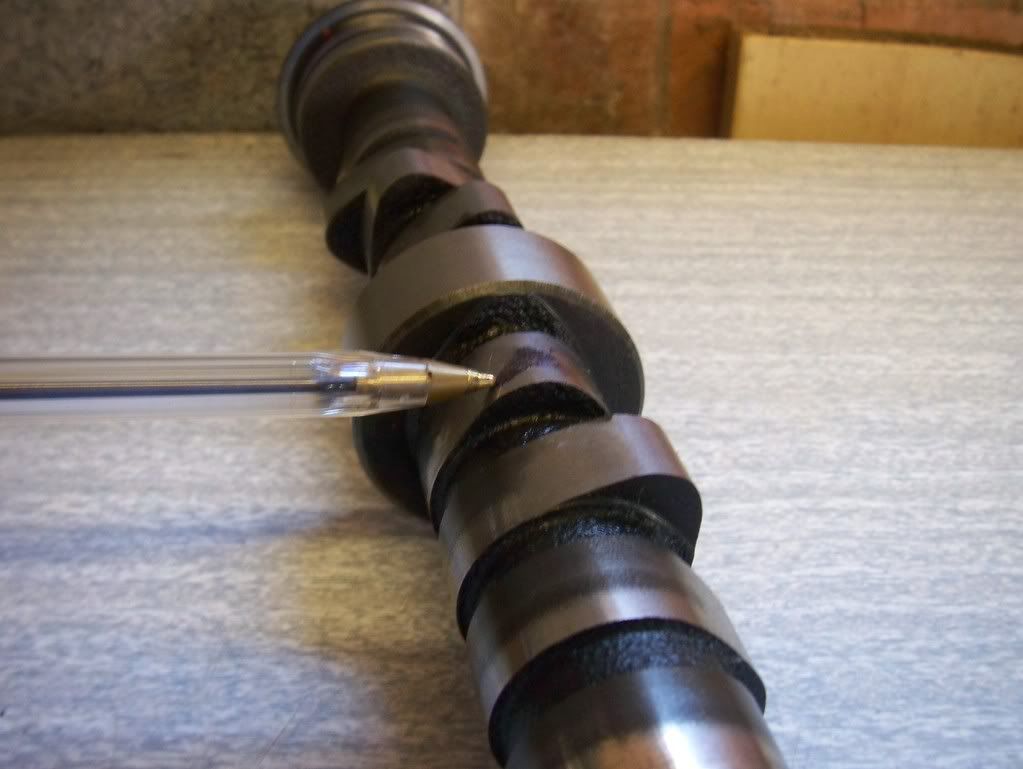
Best 11th from front of cam
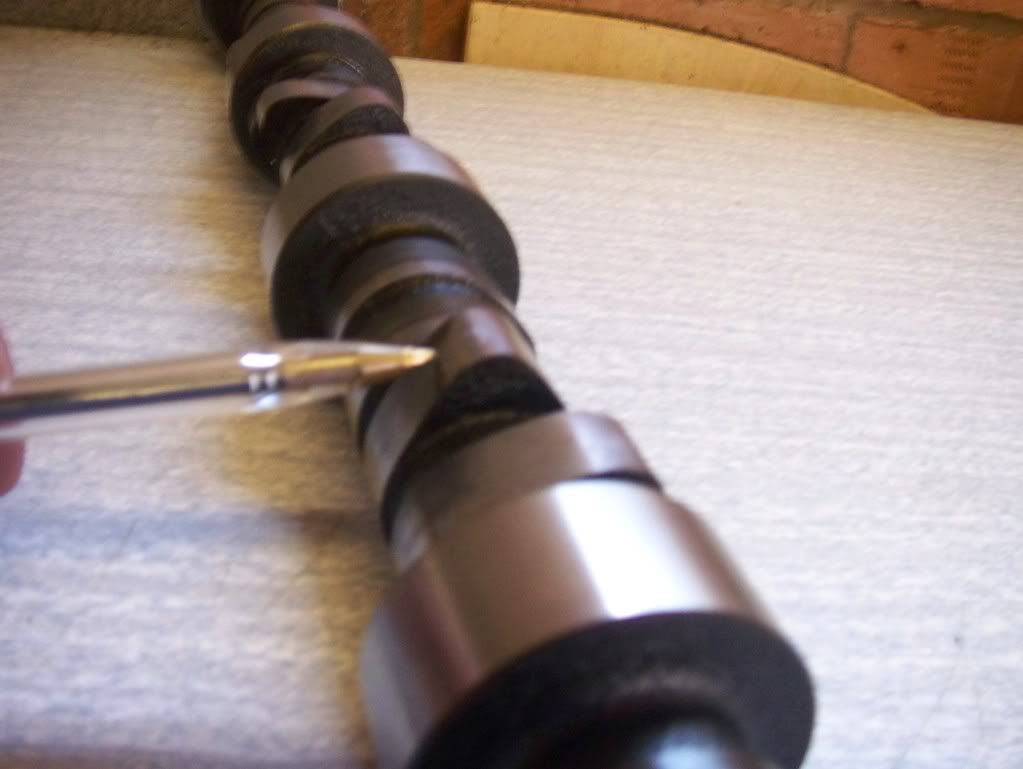
Cam id - KC is Kent Cams this is an early 90's one apparently so likely original (car is at 66k)
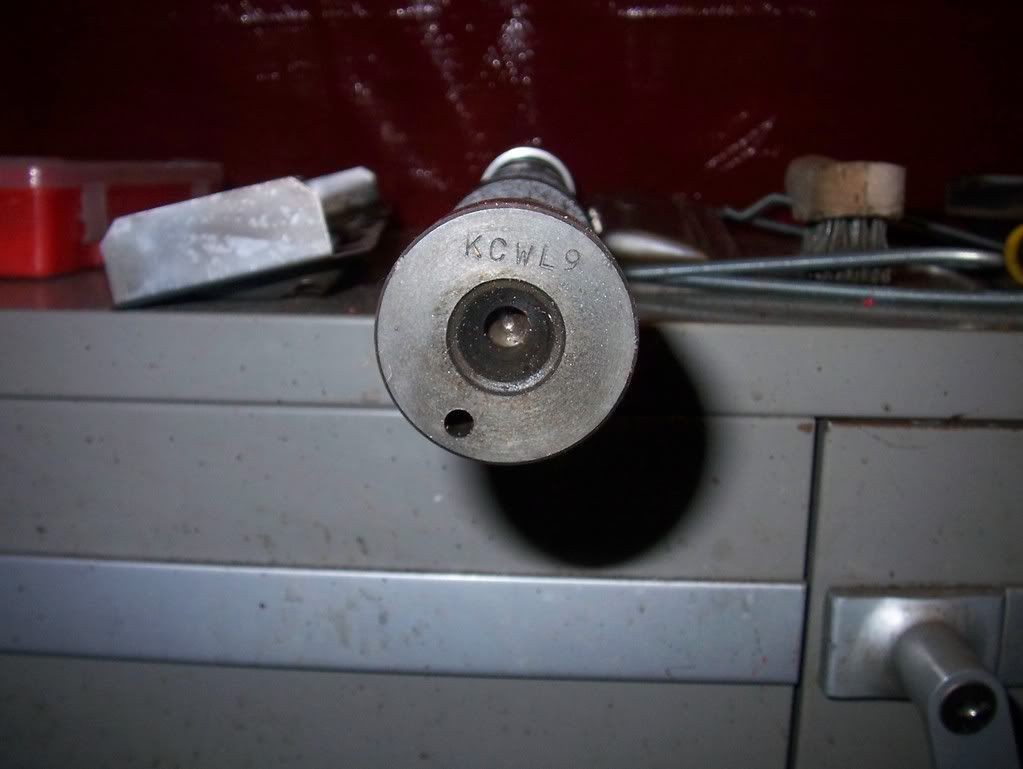
Edited by Barkychoc on Sunday 4th January 16:29
Thanks for the advice, I have checked the cam and on the end it has "270" engraved (not stamped) and at the other end it is dabbed with bright purple paint (that must mean it's ultra fast surely!). If this doesn't help identify it I can mike up the lobes.
Those pics of a knackered cam make me smile, I've spent most of my life worrying about tiny amounts of wear and polished marks/discolouration on my engines only to find some people have great big chunks of metal missing and carry on driving!
Regards
Mark
Those pics of a knackered cam make me smile, I've spent most of my life worrying about tiny amounts of wear and polished marks/discolouration on my engines only to find some people have great big chunks of metal missing and carry on driving!
Regards
Mark
Looks like that's what I've got then. Incidentally, the wear on cams is not necessarily due to oil starvation, this would be evidenced by blue discoloration. Apparently, over revving is a common problem which causes the valve springs to 'bind' destroying cams, hence it's very important to match the springs to the cam. If your engine eats cams, springs is probably the weak link.
This might be of interest.
CAST IRONS
1.HARDENABLE IRON
This is Grade 17 cast iron with an addition of 1% chrome to create 5 to 7% free carbide.
After casting, the material is flame/or induction hardened, to give a Rockwell hardness of 52 to 56 on the C Scale.
This material was developed in the 1930’s in America as a low-cost replacement for steel camshafts and is mainly suited in applications
where there is an excess of oil, i.e., camshafts that run in the engine block and that are splash-fed from the sump. (This is the material
that the Ford OHC camshafts were manufactured from).
It is not the most suitable material for performance camshafts in OHC engines.
As a company, we only use this material for performance camshafts if the camshaft is splash-fed in the sump.2.SPHEROIDAL GRAPHITE CAST IRON KNOWN AS SG IRON
A material giving similar characteristics to hardenable. Its failing as a camshaft material is hardness in its cast form, i.e., Rockwell 5,
which tends to scuff bearings in adverse conditions. The material will heat treat to 52 to 58 RockwellC. This material was used by Fiat
in the 1980’s.
3.CHILLED CHROME CAST IRON
Chilled iron is Grade 17 cast iron with 1% chrome. When the camshaft is cast in the foundry, machined steel moulds the shape of the
cam lobe are incorporated in the mould. When the iron is poured, it hardens off very quickly (known as chilling), causing the cam lobe
material to form a matrix of carbide (this material will cut glass) on the cam lobe.
This material is exceedingly scuff-resistant and is the only material for producing quantity OHC performance camshafts.
CONCLUSION OF CAST CAMSHAFTS
When purchasing a camshaft, enquire which material the camshafts are produced from. A chilled iron camshaft may be more expensive,
but its resistance to wear in all conditions, far exceeds any other type of cast iron.
By the way here at Newmans our Rover/TVR V8 cams are chilled.
CAST IRONS
1.HARDENABLE IRON
This is Grade 17 cast iron with an addition of 1% chrome to create 5 to 7% free carbide.
After casting, the material is flame/or induction hardened, to give a Rockwell hardness of 52 to 56 on the C Scale.
This material was developed in the 1930’s in America as a low-cost replacement for steel camshafts and is mainly suited in applications
where there is an excess of oil, i.e., camshafts that run in the engine block and that are splash-fed from the sump. (This is the material
that the Ford OHC camshafts were manufactured from).
It is not the most suitable material for performance camshafts in OHC engines.
As a company, we only use this material for performance camshafts if the camshaft is splash-fed in the sump.2.SPHEROIDAL GRAPHITE CAST IRON KNOWN AS SG IRON
A material giving similar characteristics to hardenable. Its failing as a camshaft material is hardness in its cast form, i.e., Rockwell 5,
which tends to scuff bearings in adverse conditions. The material will heat treat to 52 to 58 RockwellC. This material was used by Fiat
in the 1980’s.
3.CHILLED CHROME CAST IRON
Chilled iron is Grade 17 cast iron with 1% chrome. When the camshaft is cast in the foundry, machined steel moulds the shape of the
cam lobe are incorporated in the mould. When the iron is poured, it hardens off very quickly (known as chilling), causing the cam lobe
material to form a matrix of carbide (this material will cut glass) on the cam lobe.
This material is exceedingly scuff-resistant and is the only material for producing quantity OHC performance camshafts.
CONCLUSION OF CAST CAMSHAFTS
When purchasing a camshaft, enquire which material the camshafts are produced from. A chilled iron camshaft may be more expensive,
but its resistance to wear in all conditions, far exceeds any other type of cast iron.
By the way here at Newmans our Rover/TVR V8 cams are chilled.
This does explain why there's a receipt for a new cam at ~75k in the pile of paper that came with my S
Phil Mycock said:
...bonus points if you know what the two white wires with grey connectors, hanging out of the loom at rear centre of the bay are for... 
Assuming lucas haven't changed the colours they use I reckon they go to the coil, one is the +ve supply to the coil, depending on where the ballast resistor is they might both be, the other if it's not also a supply to the coil is going to be the tacho drive.
Edited by zombeh on Tuesday 6th January 18:51
GRIFFONMARK said:
Thanks for the advice, I have checked the cam and on the end it has "270" engraved (not stamped) and at the other end it is dabbed with bright purple paint (that must mean it's ultra fast surely!). If this doesn't help identify it I can mike up the lobes.
Those pics of a knackered cam make me smile, I've spent most of my life worrying about tiny amounts of wear and polished marks/discolouration on my engines only to find some people have great big chunks of metal missing and carry on driving!
Regards
Mark
If you look at the Kent Cams list, their H200 seems to be the one giving 270 duration, but it's only a mild road cam. Those pics of a knackered cam make me smile, I've spent most of my life worrying about tiny amounts of wear and polished marks/discolouration on my engines only to find some people have great big chunks of metal missing and carry on driving!
Regards
Mark

I believe their H214 or equivalent was fitted standard to most 390s, correct me if I'm wrong. - Sportier.
Mine (Chim 400HC motor) has been replaced with a Real Steel 218/220, which gives perfect tickover and it seems, plenty of power with decent economy.
Edited by grahamw48 on Tuesday 6th January 22:38
grahamw48 said:
Mine (Chim 400HC motor) has been replaced with a Real Steel 218/220, which gives perfect tickover and it seems, plenty of power with decent economy.
I've been looking at the Real Steel cams - they look a bargain at £116ish inc vat, though I think some of their bhp claims may be a bit, er, TVR 
Cam Man said:
This might be of interest.
CAST IRONS
1.HARDENABLE IRON
This is Grade 17 cast iron with an addition of 1% chrome to create 5 to 7% free carbide.
After casting, the material is flame/or induction hardened, to give a Rockwell hardness of 52 to 56 on the C Scale.
This material was developed in the 1930’s in America as a low-cost replacement for steel camshafts and is mainly suited in applications
where there is an excess of oil, i.e., camshafts that run in the engine block and that are splash-fed from the sump. (This is the material
that the Ford OHC camshafts were manufactured from).
It is not the most suitable material for performance camshafts in OHC engines.
As a company, we only use this material for performance camshafts if the camshaft is splash-fed in the sump.2.SPHEROIDAL GRAPHITE CAST IRON KNOWN AS SG IRON
A material giving similar characteristics to hardenable. Its failing as a camshaft material is hardness in its cast form, i.e., Rockwell 5,
which tends to scuff bearings in adverse conditions. The material will heat treat to 52 to 58 RockwellC. This material was used by Fiat
in the 1980’s.
3.CHILLED CHROME CAST IRON
Chilled iron is Grade 17 cast iron with 1% chrome. When the camshaft is cast in the foundry, machined steel moulds the shape of the
cam lobe are incorporated in the mould. When the iron is poured, it hardens off very quickly (known as chilling), causing the cam lobe
material to form a matrix of carbide (this material will cut glass) on the cam lobe.
This material is exceedingly scuff-resistant and is the only material for producing quantity OHC performance camshafts.
CONCLUSION OF CAST CAMSHAFTS
When purchasing a camshaft, enquire which material the camshafts are produced from. A chilled iron camshaft may be more expensive,
but its resistance to wear in all conditions, far exceeds any other type of cast iron.
By the way here at Newmans our Rover/TVR V8 cams are chilled.
Until now I'd never heard of you guys - and I'm on the PC far too much! CAST IRONS
1.HARDENABLE IRON
This is Grade 17 cast iron with an addition of 1% chrome to create 5 to 7% free carbide.
After casting, the material is flame/or induction hardened, to give a Rockwell hardness of 52 to 56 on the C Scale.
This material was developed in the 1930’s in America as a low-cost replacement for steel camshafts and is mainly suited in applications
where there is an excess of oil, i.e., camshafts that run in the engine block and that are splash-fed from the sump. (This is the material
that the Ford OHC camshafts were manufactured from).
It is not the most suitable material for performance camshafts in OHC engines.
As a company, we only use this material for performance camshafts if the camshaft is splash-fed in the sump.2.SPHEROIDAL GRAPHITE CAST IRON KNOWN AS SG IRON
A material giving similar characteristics to hardenable. Its failing as a camshaft material is hardness in its cast form, i.e., Rockwell 5,
which tends to scuff bearings in adverse conditions. The material will heat treat to 52 to 58 RockwellC. This material was used by Fiat
in the 1980’s.
3.CHILLED CHROME CAST IRON
Chilled iron is Grade 17 cast iron with 1% chrome. When the camshaft is cast in the foundry, machined steel moulds the shape of the
cam lobe are incorporated in the mould. When the iron is poured, it hardens off very quickly (known as chilling), causing the cam lobe
material to form a matrix of carbide (this material will cut glass) on the cam lobe.
This material is exceedingly scuff-resistant and is the only material for producing quantity OHC performance camshafts.
CONCLUSION OF CAST CAMSHAFTS
When purchasing a camshaft, enquire which material the camshafts are produced from. A chilled iron camshaft may be more expensive,
but its resistance to wear in all conditions, far exceeds any other type of cast iron.
By the way here at Newmans our Rover/TVR V8 cams are chilled.
You need to give your marketing department a kick up the

Edited by Barkychoc on Tuesday 6th January 22:40
I've just edited to put H200 (not 220) as 270 duration...sorry, going senile.
I think I'd go for a slightly hairier one next time, as I don't mind a bit of a lumpy tickover if it means more bhp, but I'm pretty sure you need the double valve springs and all the other matching bits when upgrading (which mine has).
but I'm pretty sure you need the double valve springs and all the other matching bits when upgrading (which mine has).
So you may have to budget a bit more...don't know if that price includes new followers (a must) and timing gear ?
I think I'd go for a slightly hairier one next time, as I don't mind a bit of a lumpy tickover if it means more bhp,
 but I'm pretty sure you need the double valve springs and all the other matching bits when upgrading (which mine has).
but I'm pretty sure you need the double valve springs and all the other matching bits when upgrading (which mine has).So you may have to budget a bit more...don't know if that price includes new followers (a must) and timing gear ?
Gassing Station | Wedges | Top of Page | What's New | My Stuff




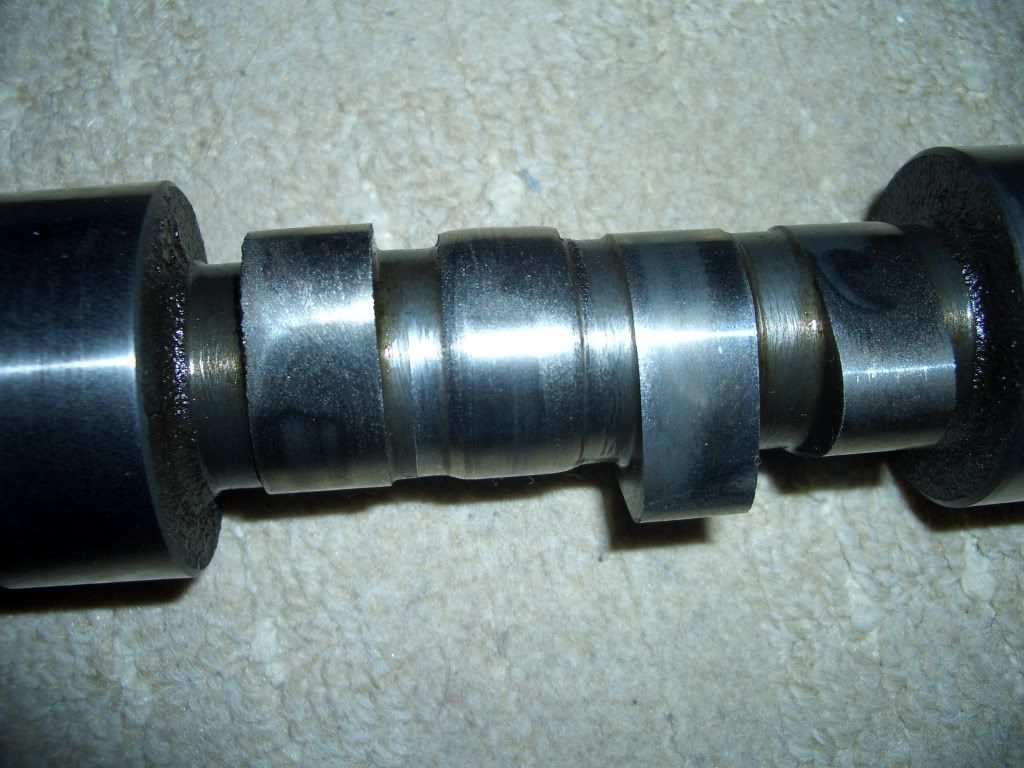
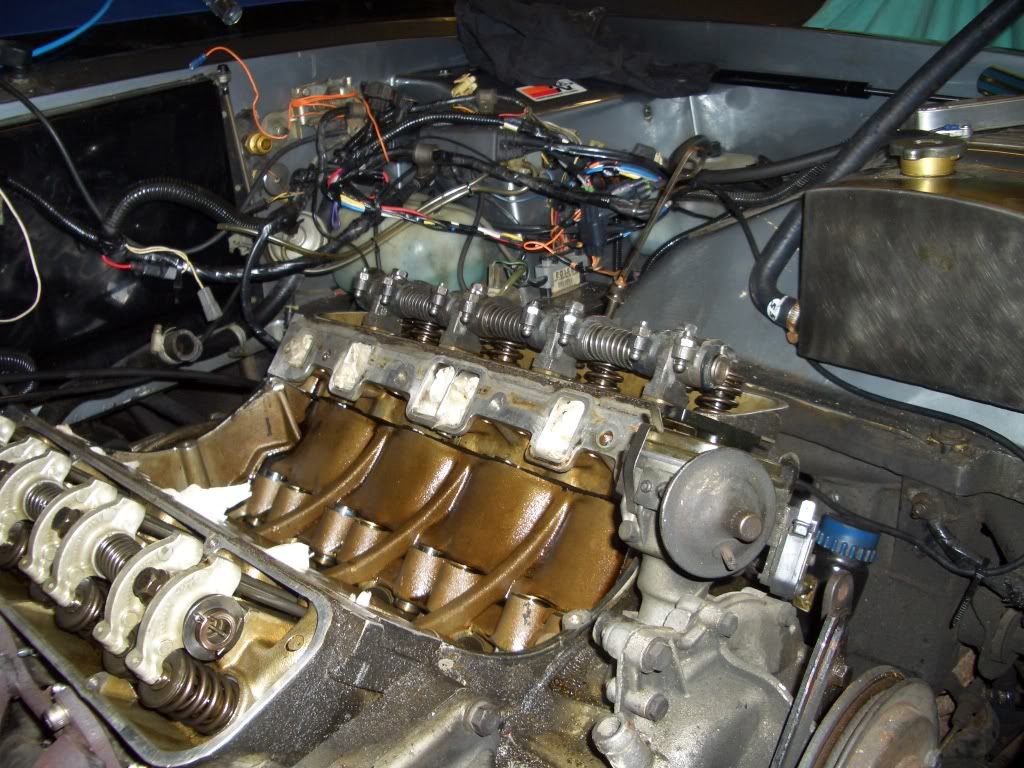

 You know, I can sense a project coming on...
You know, I can sense a project coming on...